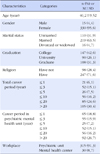Abstract
Purpose
This study was done to verify the validity and reliability of a Psychiatric Nurses' Image Scale (PSYNIS) for Korean psychiatric and mental health nurses.
Methods
A methodological study design was used with an exploratory factor analysis, Pearson's correlation, and a fitness of the modified mode for validity. Cronbach's α coefficients and an alternative-form method for reliability were used. Psychiatric Nurses' Image Scale (PSYNIS) was tested with 345 psychiatric and mental health nurses, residing in G city, J city, and J province. Data were collected from Jun. 1 to Aug. 2, 2012. Responses were obtained from respondents through self reports method and each item had a possible score of 5. Collected data were analyzed using the SPSS 20.0 and LISREL 8.54 programs.
Results
The 28 items making up the instrument were classified into the following 4 factors: 'Professionalism', 'Activism', 'Coordination competence', and 'Personalism'. These factors explained 63.2% of the total variance. Fitness of the modified mode was good (χ2= 1052.30, RMSEA=.05, GFI=.90, AGFI=.86, NFI=.97, and CFI=.98). The reliability of the PSYNIS was .95 (Cronbach's α).
References
1. Gang M. Critical thinking disposition and self-esteem of psychiatric mental health nurses. J Korean Acad Psychiatr Ment Health Nurs. 2011; 20(4):404–413. DOI: 10.12934/jkpmhn.2011.20.4.404.

2. Yang S, Kim PK. The awareness of community mental health connection chronic psychiatric patients with community mental health resource by psychiatric mental health nurses. J Korean Acad Psychiatr Ment Health Nurs. 2000; 9(4):587–598.
3. Burnard P, Fothergill A. Community mental health nurses in Wales: Self reported stressors and coping strategies. J Psychiatr Ment Health Nurs. 2000; 7:523–528.

4. Happell B, Martin T, Pinikahana J. Burnout and job satisfaction: A comparative study of psychiatric nurses from forensics and a mainstream mental health service. Int J Ment Health Nurs. 2003; 12:39–47.

5. Brown B, Crawford P, Darongkamas J. Blurred roles and permeable boundaries: the experience of multidisciplinary working in community mental health. Health Soc Care Community. 2000; 8(6):425–435.

6. Halter MJ. Perceived characteristics of psychiatric nurses: stigma by association. Arch Psychiatr Nurs. 2008; 22(1):20–26. DOI: 10.1016/j.apnu.2007.03.003.

7. Rognstad MK, Aasland O, Granum V. How do nursing students regard their future career? Career preferences in the post-modern society. Nurse Educ Today. 2004; 24(7):493–500.

8. Happell B. The role of nursing education in the perpetuation of inequality. Nurse Educ Today. 2002; 22:632–640.

9. Strasen LL. The image of professional nursing strategies for action. Philadelphia: J. B. Lippincott. Co;1990. p. 200.
10. Roberts DW. Vasquez E. Power: an application to the nursing image and advanced practice. AACN Adv Crit Care. 2004; 15(2):196–204.
11. Gulzar S, Karmaliani R, Vertejee S, Khan KS, Amarsi Y, Macfarlane J. A qualitative study of nursing leader's perceptions of professional empowerment amongst pakistani nurses. Int J Nurs Educ. 2015; 7(3):247–251. DOI: 10.5958/0974-9357.2015.00174.9.

12. Norman K. How to recruit and retain the next generation of nurses in the UK: young people's views on the image of nursing. In : 1st Annual International Conference on Nursing; 4-7 May 2015; Athens, Greece. Athens Institute for Education and Research;p. 111.
13. Kalisch BJ, Begeny S, Neumann S. The image of the nurse on the internet. Nurs Outlook. 2007; 55(4):182–188.

14. Siebens K. The professional self-image of nurses in Belgian hospitals: a cross-sectional questionnaire survey. Int J Nurs Stud. 2006; 43(1):71–82.

15. Milsen K, De Busser T, Kavaert A, Abraham I, Dierckx de CB. The evolving professional nursing self-image of students in baccalaureate programs: a cross-sectional survey. Int J Nurs Stud. 2010; 47(6):688–698. DOI: 10.1016/j.ijnurstu.2009.11.008.

16. Takase M, Maude P, Manias E. Impact of the perceived public image of nursing on nurses' work behaviour. J Adv Nurs. 2006; 53(3):333–343.

17. Malchau S. Angels in nursing: images of nursing sisters in a Lutheran context in the nineteenth and twentieth centuries. Nurs Inq. 2007; 14(4):289–298.

18. Chung YH. Theory: The development and statistics of measurement tool. Korean J Nurs Query. 2005; 14(1):88–103.
19. Kalisch PA, Kalisch BJ. Nurses on prime time television. Am J Nurs. 1982; 82:264–270.
20. Choi HW, Jung MS. Nursing images appearing in elementary school textbooks under the 7th national curriculum. J Korean Acad Nurs. 2007; 37(3):391–400.

21. Hallam J. From angels to handmaidens: changing constructions of nursing's public image in post-war Britain. Nurs Inq. 1998; 5:32–42.

22. Lusk B. Pretty and powerless: nurses in advertisements, 1930-1950. Res Nurs Health. 2000; 23:229–236.

23. Kalisch BJ, Begeny S, Neumann S. The image of the nurse on the internet. Nurs Outlook. 2007; 55(4):182–188.

24. Blais K, Hayes JS. Professional nursing practice: concepts and perspectives. New Jersey: Prentice Hall;2015. p. 530.
25. Hunter L, Weber T, Shattell M, Harris BA. Nursing students' attitudes about psychiatric mental health nursing. Issues Ment Health Nurs. 2015; 36(1):29–34.

26. Pearson GS, Evans LK, Hines-Martin VP, Yearwood EL, York JA, Kane CF. Promoting the mental health of families. Nurs Outlook. 2014; 62:225–227. DOI: 10.1016/j.outlook.2014.04.003.

27. Laschinger HK, Borgogni L, Consiglio C, Read E. The effects of authentic leadership, six areas of worklife, and occupational coping self-efficacy on new graduate nurses' burnout and mental health: a cross-sectional study. Int J Nurs Stud. 2015; 52(6):1080–1089. DOI: 10.1016/j.ijnurstu.2015.03.002.

28. Pearson GS, Hines-Martin VP, Evans LK, York JA, Kane CF, Yearwood EL. Addressing gaps in mental health needs of diverse, at-risk, underserved, and disenfranchised populations: a call for nursing action. Arch Psychiatr Nurs. 2015; 29(1):14–18. DOI: 10.1016/j.apnu.2014.09.004.

29. Heo EH, Jeong IS. Perceptions and experiences of referral to community-based mental health services among nurses in psychiatric hospitals. Glob Health Nurs. 2015; 5(1):9–17.
30. Sercu C, Ayala RA, Bracke P. How does stigma influence mental health nursing identities? An ethnographic study of the meaning of stigma for nursing role identities in two Belgian Psychiatric Hospitals. Int J Nurs Stud. 2015; 52(1):307–316. DOI: 10.1016/j.ijnurstu.2014.07.017.





 PDF
PDF ePub
ePub Citation
Citation Print
Print







 XML Download
XML Download